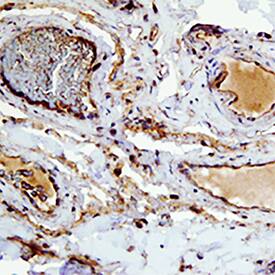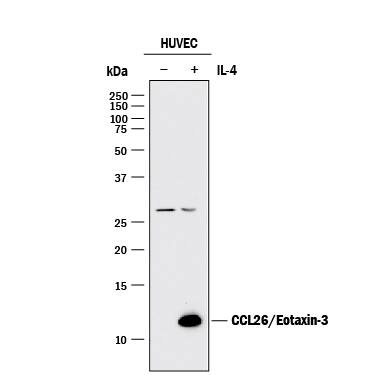Human CCL26/Eotaxin-3 Antibody
R&D Systems, part of Bio-Techne | Catalog # AF653

Key Product Details
Validated by
Species Reactivity
Validated:
Cited:
Applications
Validated:
Cited:
Label
Antibody Source
Product Specifications
Immunogen
Thr24-Leu94
Accession # Q9Y258
Specificity
Clonality
Host
Isotype
Endotoxin Level
Scientific Data Images for Human CCL26/Eotaxin-3 Antibody
Detection of Human CCL26/Eotaxin‑3 by Western Blot.
Western blot shows lysates of HUVEC human umbilical vein endothelial cells untreated (-) or treated (+) with 100 U/mL Recombinant Human IL-4 (Catalog # 204-IL) for 24 hours. PVDF membrane was probed with 1 µg/mL of Goat Anti-Human CCL26/Eotaxin-3 Antigen Affinity-purified Polyclonal Antibody (Catalog # AF653) followed by HRP-conjugated Anti-Goat IgG Secondary Antibody (Catalog # HAF017). A specific band was detected for CCL26/ Eotaxin-3 at approximately 12 kDa (as indicated). This experiment was conducted under reducing conditions and using Immunoblot Buffer Group 1.CCL26/Eotaxin-3 in Human Colon (Vasculature).
CCL26/Eotaxin-3 was detected in immersion fixed paraffin-embedded sections of human colon (vasculature) using Goat Anti-Human CCL26/Eotaxin-3 Antigen Affinity-purified Polyclonal Antibody (Catalog # AF653) at 15 µg/mL for 1 hour at room temperature followed by incubation with the Anti-Goat IgG VisUCyte™ HRP Polymer Antibody (VC004). Before incubation with the primary antibody, tissue was subjected to heat-induced epitope retrieval using Antigen Retrieval Reagent-Basic (CTS013). Tissue was stained using DAB (brown) and counterstained with hematoxylin (blue). Specific staining was localized to cell surface on endothelial cells. Staining was performed using our protocol for IHC Staining with VisUCyte HRP Polymer Detection Reagents.Chemotaxis Induced by CCL26/Eotaxin‑3 and Neutralizatio by Human CCL26/Eotaxin‑3 Antibody.
Recombinant Human CCL26/Eotaxin-3 (Catalog # 346-E3) chemoattracts the BaF3 mouse pro-B cell line transfected with mouse CCR3 in a dose-dependent manner (orange line). The amount of cells that migrated through to the lower chemotaxis chamber was measured by Resazurin (Catalog # AR002). Chemotaxis elicited by Recombinant Human CCL26/Eotaxin-3 (1 µg/mL) is neutralized (green line) by increasing concentrations of Human CCL26/Eotaxin-3 Antigen Affinity-purified Polyclonal Antibody (Catalog # AF653). The ND50 is typically 4-24 µg/mL.Applications for Human CCL26/Eotaxin-3 Antibody
Immunohistochemistry
Sample: Immersion fixed paraffin-embedded sections of human colon (vasculature)
Western Blot
Sample: HUVEC human umbilical vein endothelial cells treated with Recombinant Human IL‑4 (Catalog # 204-IL)
Neutralization
Formulation, Preparation, and Storage
Purification
Reconstitution
Formulation
Shipping
Stability & Storage
- 12 months from date of receipt, -20 to -70 °C as supplied.
- 1 month, 2 to 8 °C under sterile conditions after reconstitution.
- 6 months, -20 to -70 °C under sterile conditions after reconstitution.
Background: CCL26/Eotaxin-3
Eotaxin-3, also named CCL26 or SCYA26, is a novel human CC chemokine that maps to chromosome 7q11.2, within 40 kilobases of the Eotaxin-2 loci. Eotaxin‑3/CCL26 has been shown to be constitutively expressed in the heart and ovary. In addition, low levels of Eotaxin-3/CCL26 expression can also be detected in various tissues. The expression of Eotaxin-3/CCL26 in vascular endothelial cells has been shown to be up-regulated by IL-13 and IL-4.
Eotaxin-3/CCL26 cDNA encodes a 94 amino acid (aa) residue protein with a putative signal peptide of either 23 or 26 aa residues. Recombinant Eotaxin-3/CCL26 has been produced in insect cells using a baculovirus expression system and shown to contain 71 aa residues. Recombinant Eotaxin-3/CCL26 is chemotactic for eosinophils and PHA-activated T cells. Eotaxin-3/CCL26 induces calcium flux in eosinophils as well as in CCR3-transfected cells. Eotaxin-3/CCL26 has also been shown to cross-desensitize cells to other CCR3 ligands. Both the 71 aa residue and 68 aa residue variants of recombinant Eotaxin-3 have been expressed in E. coli and found to have equal potency in inducing chemotaxis of a human CCR3-transfected cell line.
References
- Gou, R.F. et al. (1999) Genomics 58:313.
- Kitamura, M. et al. (1999) J. Biol. Chem. 274:27975.
- Shinkai, A. et al. (1999) J. Immunol. 163:1602.
Alternate Names
Entrez Gene IDs
Gene Symbol
UniProt
Additional CCL26/Eotaxin-3 Products
Product Documents for Human CCL26/Eotaxin-3 Antibody
Product Specific Notices for Human CCL26/Eotaxin-3 Antibody
For research use only


